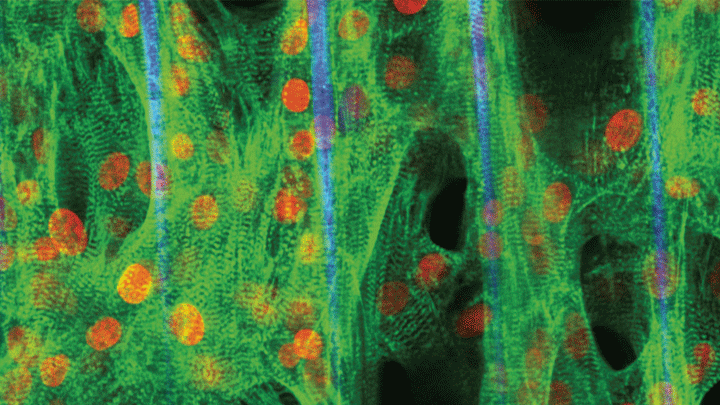hypertrophic cardiomyopathy
Modeling Hypertrophic Cardiomyopathy in a Dish
Posted on by Dr. Francis Collins

Credit: Zhen Ma, University of California, Berkeley
Researchers have learned in recent years how to grow miniature human hearts in a dish. These “organoids” beat like the real thing and have allowed researchers to model many key aspects of how the heart works. What’s been really tough to model in a dish is how stresses on hearts that are genetically abnormal, such as in inherited familial cardiomyopathies, put people at greater risk for cardiac problems.
Enter the lab-grown human cardiac tissue pictured above. This healthy tissue comprised of the heart’s muscle cells, or cardiomyocytes (green, nuclei in red), was derived from induced pluripotent stem (iPS) cells. These cells are derived from adult skin or blood cells that are genetically reprogrammed to have the potential to develop into many different types of cells, including cardiomyocytes.
A Look Inside a Beating Heart Cell
Posted on by Dr. Francis Collins
Caption: Microtubules (blue) in a beating heart muscle cell, or cardiomyocyte. Credit: Lab of Ben Prosser, Ph.D., Perelman School of Medicine, University of PennsylvaniaYou might expect that scientists already know everything there is to know about how a healthy heart beats. But researchers have only recently had the tools to observe some of the dynamic inner workings of heart cells as they beat. Now an NIH-funded team has captured video to show that a component of a heart muscle cell called microtubules—long thought to be very rigid—serve an unexpected role as molecular shock absorbers.
As described for the first time recently in the journal Science, the microtubules buckle under the force of each contraction of the muscle cell before springing back to their original length and form. The team also details a biochemical process that allows a cell to fine-tune the level of resistance that the microtubules provide. The findings have important implications for understanding not only the mechanics of a healthy beating heart, but how the abnormal stiffening of heart cells might play a role in various forms of cardiac disease.
